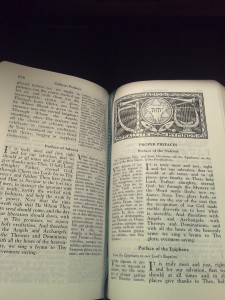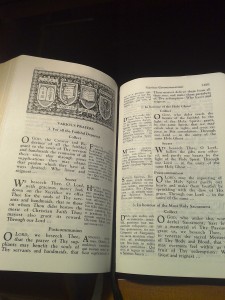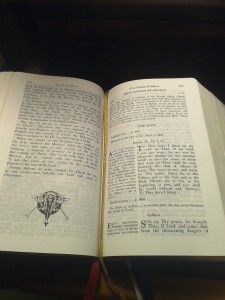A hand missal is a handy tool for learning and following the Mass. But the pages don’t flip themselves. In order to use a missal, one has to know the parts of the book.
Anatomy of a Hand Missal
The first major division in a hand missal is between Mass parts and other devotions. Many hand missals contain prayers for before and after Holy Communion, daily prayers, the Stations of the Cross, abridgements of the office, litanies, sacraments, and the like. For the most part, these directions concern only the parts of the Mass.
Propers & the Ordinary. The Mass is made up of the Ordinary, which always remains the same, and the Propers, which change based on the liturgical day. The Propers come in two “flavors,” the Proper of the Season and the Proper of Saints. The former contains the Masses for Sundays and movable feasts, the dates of which depend on that of Easter. The latter contains the Masses for fixed feasts always falling on the same day of the year. (Because Christmas and the feasts during Christmastide always comes after the Fourth Sunday of Advent, you will find Christmas and the Octave of the Nativity in the Proper of the Season.)
For instance, in the Baronius Press Missal, the Proper of the Seasons begins on page 141 with a section introduction, and the first Sunday of Advent follows on page 143.These Propers run through the whole liturgical year to page 869, where the twenty-fourth Sunday after Pentecost ends. Going Sunday by Sunday, one would move through the whole interval during the year (perhaps skipping a few celebrations like the Rogation Days, when Mass in the EF might not be offered).
In most years, of course, one will have to do some flipping at the very end of the liturgical year, as propers listed under Sundays after Epiphany are used in the last Sundays after Pentecost: where those propers (and corresponding Sundays) fall depends on the date of Easter. Most hand missals will have a table in which you can cross-reference the total number of Sundays after Pentecost to determine how many, if any, of the “after Epiphany” propers to use, and when to use them.
A few pages later begins the Ordinary, which runs about eighty pages in the Baronius Missal.
Prefaces. The division of the order of Mass into “proper” and “ordinary” has one exception: the preface. The preface generally corresponds to the season, rather than simply the day, although some particular feasts have unique prefaces. There are fifteen “proper prefaces” and five “Gallican prefaces” in the 1962 Roman Missal. The Gallican prefaces (“Gallican” because they were part of the French Gallican Rite that more or less disappeared in favor of the Roman Rite in the eighth century) are among the only optional prayers in the 1962 Missale Romanum: on a day for which there is a Gallican preface, the priest can choose to use a Gallican preface in place of the proper preface (optional commemorations, or extra collects for special intentions, are about the only other optional prayers). The prefaces are likely placed all together in the missal, perhaps (as in the Baronius missal) between the proper of the season and the ordinary.

Commons. A daily missal will also contain a section of “Commons.” The Masses for most saints’ feasts do not contain a full set of propers. Instead, the remaining propers are filled in with those from the Common that corresponds to the saint’s status, such as martyr, virgin, apostle, bishop, etc. The Commons may come after the Ordinary but before the Proper of Saints. (Pages 981–1094 in the Baronius Missal.) Generally, these commons will only be used in weekday Masses, as the lesser-class feasts for which they are used do not preempt a Sunday’s liturgical observance.
Supplemental Propers. At the very end of a missal there is often a Supplement, containing propers (or references to appropriate propers elsewhere in the book) for feasts celebrated in particular places but not on the universal calendar. For instance, in Nashville, all churches except the cathedral are permitted to celebrate the commemoration of their consecration as a first-class feast on May 23.
Using the Missal.
In order to use the missal to follow the Mass, one will need to be able to flip from the Ordinary to the day’s propers and back again. So, the first step is:
1. Determine the Liturgical Day. You can always find out where a day falls on the liturgical calendar at Divinum Officium. The Latin Mass Society also has a liturgical calendar online (Sundays should be the same in the U.S. and U.K.). You could also simply consult the table of movable feasts in the beginning of your missal and do some math. (For the record, Sunday August 9, 2015, will be the 11th Sunday after Pentecost.)
Once you know what day it is, the second step is:
2. Set the Propers Ribbon to That Day. There you will have the introit, readings, and other prayers of the day all in the order in which they appear in the Mass. Because Sundays and major feast days are collected separately from saints’ days, you ought not have to preset this ribbon very often: at the end of one week’s Mass, it will be at the beginning of next week’s. Caveat: read “saints’ days” as including all feasts that (1) are fixed on a particular day and (2) are not tied to a particular season (like Christmas is tied to Advent); even if it’s not a saints’ day, per se, propers for those days are going to be in the Proper of Saints, in a different part of the book.
3. Set the Ordinary Ribbon to the Asperges and go from there. Unless your Mass is not a Sunday Mass or not the week’s “principal” Mass, it will be preceded by the Asperges. Set the ordinary ribbon there. You won’t need it until the Introit. Then, use the ordinary ribbon to hold your place while you flip to the Propers ribbon and read the Introit. (Or, if the entrance procession is accompanied by a hymn, instead of the chanted Introit, you might proceed with the Ordinary and flip to the Propers after the Asperges.)
That process can be repeated for each of the variable parts. At the end of Mass, just move the Ordinary ribbon back to the Asperges and you should be set for next week. There are only a few places where non-Sunday Masses, like those for Ember Days, which may not be celebrated in the average parish, will be in between one Sunday and the next in the Proper of the Seasons. If you encounter one of those, just move your Proper ribbon to the next Sunday.
4. Optional: Preface & Devotional Ribbons. You can get through the Mass just fine with only the markers for the propers and your spot in the Ordinary. But many people may want to read the specific preface of the day (which will be with other prefaces, not with either the propers or the ordinary). Those can warrant a third ribbon when available. Also, many of these hand missals have a wonderful collection of devotions for before or after Mass, or in preparation or thanksgiving for receiving the Eucharist. A ribbon there to keep one’s favorite Eucharistic devotions is handy.

* * *
One doesn’t have to use a hand missal to assist at Mass in the Extraordinary Form, and trying to do so too assiduously while also keeping children alive and behaved can be a frustrating challenge. But having one to consult can be helpful. The real trick is to get a feel for the book and the Mass itself. But hopefully this guide can give a newcomer to the E.F. a step up in utilizing a hand missal to orient himself.

I bought I Baronius Press Roman Missal (1962) but actually published in 2020 it says. I have yet to find a daily reading in the book that matches the daily readings listed formally on various Catholic websites. It’s become quite frustrating. I have repeatedly searched the “How to guides” online but to no avail. For instance tomorrow 5FEB21 the readings in the BP Roman Missal (pg 1176) are: Corinthians 1. 26-31, Ps. 45. 6 and 5, Gospel (refer to pg 1055) Matthew 19. 3-12 Meanwhile, I go online to https://www.catholic.org/bible/daily_reading/?select_date=2021-02-05 and the readings for that day are Reading 1, Hebrews 13:1-8, Responsorial Psalm, Psalms 27:1, 3, 5, 8-9, Gospel, Mark 6:14-29 It’s not even close? There’s no other indication I can find in the BP Missal of an alternate reading or reference that matches with what is listed online? I am obviously in over my head and missing something.
LikeLike
Chris, thanks for the question. I hope you check back or have followed this thread, because the computer doesn’t seem to give me a way to e-mail you.
But the short answer is that the Baronius Missal and the readings online at Catholic.org or the USCCB’s “Daily Readings” page are using different lectionaries and different calendars. Most websites give you the readings for the day derived from the General Roman Calendar of 1970 (as amended) and the lectionary attached to the 2002 typical edition of the Roman Missal. Those give you the readings used in the “ordinary form.” That cycle of readings first entered use in 1970.
The Baronius Missal, by contrast, is keyed to the General Roman Calendar of 1960 and the readings set forth in the 1962 edition of the Roman Missal. The lectionary contained in that version of the missal (it was smaller and didn’t need the four extra books required to house the 1970 lectionary) had been in use among Roman Catholics since the 9th century (and the Sunday readings since the 5th) before it was unceremoniously ash-canned for most purposes in 1969-70.
So just the way you won’t hear the exact same order of Mass set out in the Baronius Missal if you go to your average local American parish, because the rite has been changed, you won’t hear the same readings because the lectionary has been changed. For further reading on this topic, you might look to this post, which has several helpful links: https://nashvilletlm.wordpress.com/2015/07/19/the-extraordinary-form-lectionary/
LikeLike
I appreciate the feedback. I feel silly now and had been driving myself mad trying to figure out the disconnect, thinking I just didn’t know how to use it. Sadly, I wish I had known this before I bought it, because I wanted a Missal that would simply cover all the readings for all the years (A, B, C) in one simple book, and also have the Ordinary of the Mass (in line with modern listed readings). The rest of the book is absolutely fantastic. What a shame. I should have done a bit more homework beforehand.
-God Bless
LikeLike
Chris, sorry for the mixup. I think your best bet for the ordinary-form cycle is the St. Joseph daily and Sunday set, which is three volumes. (There are a few other publishers that put these out, but St. Joseph is widely available.) I have honestly never seen the entire OF lectionary in one book; I think it would be too big to use as a hand missal. Happy feast of St. Agatha, and happy book-shopping.
LikeLike
Thanks for the recommendation. I was looking at the St. Joseph’s three volume set or the St. Paul Daily Missal. It seems like the St. Joseph’s set would be the safe bet, as for what I am after. Now I’m wondering what to do with my Baronius Missal? I’m thinking of donating but not sure to whom.
God BlessChris
LikeLike
If there’s a parish in your town that offers the traditional Latin Mass, they would find it a good home. Or they tend to sell on Amazon or ebay. I always keep a random liturgical book I wind up with or come across for reference, but I’m something of a bibliophile anyways.
LikeLike